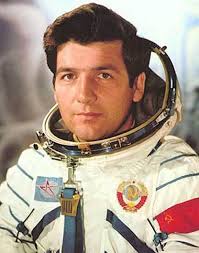Pyotr Klimuk
Belarusian - (RFSA)
Retired
Date of Birth: July 10, 1942
Age: 83
Pyotr Ilyich Klimuk (Belarusian: Пётр Ільіч Кліму́к; Russian: Пётр Ильич Климу́к; born 10 July 1942) is a former Soviet cosmonaut and the first Belarusian to perform space travel. Klimuk made three flights into space. Klimuk attended the Leninski Komsomol Chernigov High Aviation School and entered the Soviet Air Force in 1964. The following year, he was selected to join the space programme. His first flight was a long test flight on Soyuz 13 in 1973. This was followed by a mission to the Salyut 4 space station on Soyuz 18 in 1975. From 1976 he became involved in the Intercosmos and made his third and final spaceflight on an Intercosmos flight with Polish cosmonaut Mirosław Hermaszewski on Soyuz 30.
Soyuz | Soyuz 13
Russian Federal Space Agency (ROSCOSMOS) | RussiaBaikonur Cosmodrome, Republic of Kazakhstan
Dec. 18, 1973, 11:55 a.m.
Status: Success
Mission:
Soyuz 13 launched on 18 December 1973, 11:55:00 UTC. It carried commander Pyotr Klimuk and flight engineer Valentin Lebedev into orbit. This mission was the second test flight of the modified Soyuz spacecraft. Crew spent 7 deays in orbit and carried out various astrophysical studies. They also obtained ultraviolet spectrograms of stars with the help of an Orion 2 Space Observatory onboard the spacecraft. Crew returned to Earth, landing on 26 December 1973, 08:50:35 UTC.
Low Earth OrbitSoyuz | Soyuz 18
Russian Federal Space Agency (ROSCOSMOS) | RussiaBaikonur Cosmodrome, Republic of Kazakhstan
May 24, 1975, 2:58 p.m.
Status: Success
Mission:
Soyuz 18 was the second and final crew to man the Salyut 4 space station. The mission began on May 24th 1975 at 1458:10 UTC, launching Commander Pyotr Klimuk & Flight Engineer Vitali Sevastyanov into orbit docking with Salyut 4 2 days later. They stayed on the station for 63 days setting a new Soviet space endurance record at the time. Klimuk & Sevastyanov were the back-up crew for the failed Soyuz 18a mission so their mission goals included completing the goals of Soyuz 18a, continuing the work of Soyuz 17 & fixing or replacing equipment. They replaced a gas analyzer, switched a pumping condenser in the water regeneration system with a hand pump & fixed a spectrometer. Mostly the experiments were biological & medical but they also studied stars, planets, earth and its atmosphere with roughly 2000 photographs of Earth and 600 of the sun taken. The mission concluded with a safe landing on June 26th 1975 at 1418:18 UTC.
Low Earth OrbitSoyuz-U | Soyuz 30
Russian Federal Space Agency (ROSCOSMOS) | RussiaBaikonur Cosmodrome, Republic of Kazakhstan
June 27, 1978, 3:27 p.m.
Status: Success
Mission:
Soyuz 30 was the fifth mission to visit the Salyut 6 space station and carried the the EP-3 crew, which visited the long-duration Soyuz 29 resident crew. The mission began on June 27, 1978, 15:27:21 UTC, launching Commander Pyotr Klimuk and Research Engineer Mirosław Hermaszewski, the first Polish cosmonaut, into orbit. They docked with the station the next day. During their 7-day stay on the station, crew conducted various scientific and medical experiments. The mission concluded with a safe landing back on Earth on July 5, 1978, 13:30:20 UTC.
Low Earth OrbitThe Roscosmos State Corporation for Space Activities, commonly known as Roscosmos, is the governmental body responsible for the space science program of the Russian Federation and general aerospace research. Soyuz has many launch locations the Russian sites are Baikonur, Plesetsk and Vostochny however Ariane also purchases the vehicle and launches it from French Guiana.
Falcon 9
Starlink Group 15-13
Space Launch Complex 4E - Vandenberg SFB, CA, USAA batch of 27 satellites for the Starlink mega-constellation - SpaceX's project for space-based Internet communication system.
Falcon 9
Starlink Group 6-99
Launch Complex 39A - Kennedy Space Center, FL, USAA batch of 29 satellites for the Starlink mega-constellation - SpaceX's project for space-based Internet communication system.
Ariane 62
Galileo L14 (FOC FM33 & FM34)
Ariane Launch Area 4 - Guiana Space Centre, French GuianaPayload consists of two satellites for Europe's Galileo navigation system.
Atlas V 551
Amazon Leo (LA-04)
Space Launch Complex 41 - Cape Canaveral SFS, FL, USAAmazon Leo, formerly known as Project Kuiper, is a mega constellation of satellites in Low Earth Orbit that will offer broadband internet access, thi…
Long March 4B
Ziyuan-3-04
Launch Complex 9 - Taiyuan Satellite Launch Center, People's Republic of ChinaThe ZY-3 (Ziyuan-3, 'Resource-3') series represents China's first high-resolution, stereoscopic mapping satellites for civilian use. The second sa…



